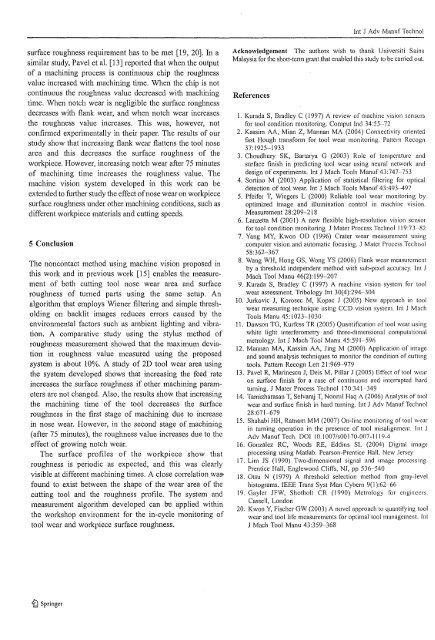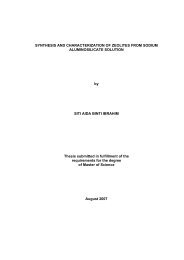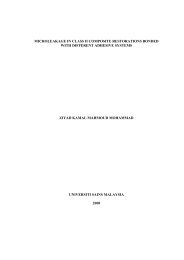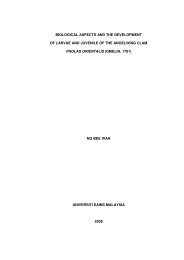Laporan Akhir Projek Penyelidikan Jangka Pendek ... - ePrints@USM
Laporan Akhir Projek Penyelidikan Jangka Pendek ... - ePrints@USM
Laporan Akhir Projek Penyelidikan Jangka Pendek ... - ePrints@USM
Create successful ePaper yourself
Turn your PDF publications into a flip-book with our unique Google optimized e-Paper software.
Int J Adv ManuI' Technolsurface roughness requirement has to be met [19, 20]. In asimilar study, Pavel et a1. [13] reported that when the outputof a machining process is continuous chip the roughnessvalue increased with machining time. When the chip is notcontinuous the roughness value decreased with machiningtime. When notch wear is negligible the surface roughnessdecreases with flank wear, and when notch wear increasesthe roughness value increases. This was, however, notconfinned experimentally in their paper. The results of ourstudy show that increasing flank wear flattens the tool nosearea and this decreases the surface roughness of theworkpiece. However, increasing notch wear after 75 minutesof machining time increases the roughness value. Themachine vision system developed in this work can beextended to further study the effect ofnose wear on workpiecesurface roughness under other machining conditions, such asdifferent workpiece materials and cutting speeds.5 ConclusionThe noncontact method using machine vision proposed inthis work and in previous work [15] enables the measurementof both cutting tool nose wear area and surfaceroughness of turned parts using the same setup. Analgorithm that employs Wiener filtering and simple thresholdingon backlit images reduces errors caused by theenvironmental factors such as ambient lighting and vibration.A comparative study using the stylus method ofroughness measurement showed that the maximum deviationin roughness value measured using the proposedsystem is about 10%. A study of 2D tool wear area usingthe system developed shows that increasing the feed rateincreases the smface roughness if other machining parametersare not changed. Also, the results show that increasingthe machining time of the tool decreases the surfaceroughness in the first stage of machining due to increasein nose wear. However, in the second stage of machining(after 75 minutes), the roughness value increases due to theeffect of growing notch wear.The surface profiles of the workpiece show thatroughness is periodic as expected, and this was clearlyvisible at different machining times. A close correlation wasfoundto exist between the shape of the wear area of thecutting tool and the roughness profile. The system andmeasurement algorithm developed can be applied withinthe workshop environment for the in-cycle monitoring oftool wear and workpiece surface roughness.Acknowledgement The authors wish to thank Universiti SainsMalaysia for the short-term grant that enabled this study to be calTied out.ReferencesI. Kurada S, Bradley C (1997) A review of machine vision sensorsfor tool condition monitoring. Comput Ind 34:55-722. Kassim AA, Mian Z, Mannan MA (2004) Connectivity orientedfast Hough transform for tool wear monitoring. Pattem Recogn37: 1925-19333. Choudhury SK, Bartarya G (2003) Role of temperature andsurface finish in predicting tool wear using neural network anddesign of experiments. Int J Mach Tools ManuI' 43:747-7534. Sortino M (2003) Application of statistical filtering for opticaldetection of tool wear. Int J Mach Tools ManuI' 43:493-4975. Pfeifer T, Wiegers L (2000) Reliable tool wear monitoring byoptimized image and illumination control in machine vision.Measurement 28:209-2186. Lanzetta M (200 I) A new flexible high-resolution vision sensorfor tool condition monitoring. J Mater Process Technol 119:73827. Yang MY, Kwon OD (1996) Crater wear measurement usingcomputer vision and automatic focusing. J Mater Process Technol58:362-3678. Wang WH, Hong GS, Wong YS (2006) Flank wear measurementby a threshold independent method with sub-pixel accuracy. 1m .JMach Tool Manu 46(2): 199-2079. Kurada S, Bradley C (1997) A machine vision system for toolwear assessment. Tribology Int 30(4):294-30410. Jurkovic J, Korosec M, Kopac J (2005) New approach in toolwear measuring technique using CCD vision system. Int J MachTools Manu 45:1023-1030II. Dawson TG, Kurfess TR (2005) Quantification of tool wear usingwhite light intelferometry and three-dimensional computationalmelt·ology. Int .J Mach Tool Manu 45:591--59612. Mannan MA, Kassim AA, Jing M (2000) Application of imageand sound analysis techniques to monitor the condition of cuttingtools. Pattern Recogn Lett 21 :969.. 97913. Pavel R, Marinescu J, Deis M, Pillar J (2005) Effect of tool wearon surface finish for a case of continuous and interrupted hardturning. J Mater Process Technol 170:34134914. Tamizharasan T, Selvaraj T, Noorul Haq A (2006) Analysis of toolwear and surface finish in hard turning. Int J Adv ManufTechnol28:671-679IS. Shahabi HH, Ratnam MM (2007) On-line monitoring of tool wearin turning operation in the presence of tool misalignment. Int JAdv ManuI' Tech. DOl 10.1007/s00170-007-1119-416. Gonzalez RC, Woods RE, Eddins SL (2004) Digital imageprocessing using Matlab. Pearson-Prentice Hall, New Jersey17. Lim JS (1990) Two-dimensional signal and image processing.Prentice Hall, Englewood Cliffs, NJ, pp 536-54018. Otsu N (1979) A threshold selection method tl'om gray-levelhistograms. IEEE Trans Syst Man Cybem 9( 1):62-6619. Gayler JFW, Shotbolt CR (1990) Metrology for engineers.Cassell, London20. Kwon Y, Fischer GW (2003) A novel approach to quantifying toolwear and tool life measurements for optimal tool management. IntJ Mach Tool Manu 43:359-368~ Springer
















